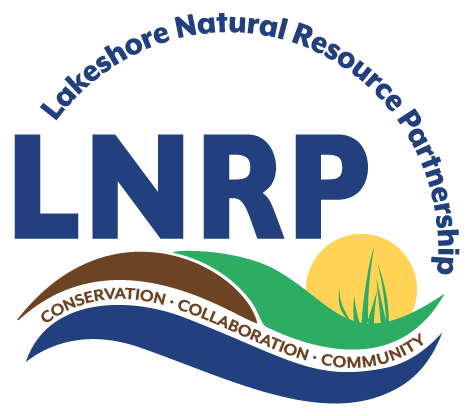A Regional Approach to Controlling the Spread of Invasive Phragmites
Invasive species can cause widespread damage to ecosystems, reducing overall health, biodiversity, and climate resilience. That’s why a collaborative team called the Lakeshore Invasive Species Management Area (LISMA) has been working on invasive Phragmites control efforts for over 10 years throughout northeast Wisconsin. Lakeshore Natural Resource Partnership (LNRP), Glacierland Resource Conservation & Development Council (RC&D), Fox Wolf Watershed Alliance, and Stantec Consulting Services Inc. are championing LISMA to protect and enhance the resiliency of the Great Lakes region through an innovative, grassroots approach.
Phragmites Impacts
Pictured: Shoreline Phragmites
Phragmites, specifically Phragmites australis subsp. australis, is a non-native tall reed (8 to 10 feet!) that is taking over wetlands, rivers, shoreline habitats, and roadside ditches. Phragmites degrades ecosystems by crowding out native plants and establishing itself as dominant. In doing so, it provides little or no food value and threatens critical nesting, foraging, and spawning habitats for native animals. Moreover, Phragmites dramatically reduces the biodiversity of the ecosystem it enters. This, in turn, reduces the ecosystem’s resilience and disrupts natural ecological processes and systems. Control is necessary to curb the negative effects on biodiversity and ecological functions of invaded habitats; to minimize loss of recreational use of wetlands, shorelines, and waterways; and to protect economic assets including tourism, property values, and safe navigation.
A Regional Approach
LISMA takes a regional approach to Phragmites control because invasive species do not adhere to state, county, and municipal borders. Addressing Phragmites regionally requires a dedicated and comprehensive approach, partnerships to leverage shared resources, funding to sustain and expand efforts, and long-term, locally supported control strategies. So far LISMA has led Phragmites mitigation efforts across six counties in northeast Wisconsin that represent a significant portion of Wisconsin’s Lake Michigan basin: Kewaunee, Manitowoc, Sheboygan, Ozaukee, Fond du Lac, and Calumet. Complementary planning and treatment efforts are also underway in adjacent Winnebago, Waupaca, Outagamie and Brown counties. In each county the LISMA team prioritizes ecologically sensitive communities along shorelines, coastal wetlands, inland waterways and connected wetlands, and roadside ditches, which are main pathways for regional invasion.
Pictured: LISMA team member treating mature Phragmites
Photo Credit: Stantec
How LISMA Controls Phragmites
Pictured: Mapped invasive species
The LISMA team works on public land and with private landowners wherever Phragmites colonies are identified. Partnerships with local municipalities and their residents are crucial to controlling these destructive reeds. Thus, outreach to people whose properties contain invasive Phragmites has been a vital part of this project’s success. Thanks to grant funding totaling over $4 million since 2012, the LISMA team provides Phragmites control measures to landowners completely free of charge. Thousands of landowner parcels have been enrolled in this program and the public is very supportive of continuing treatments.
Given its long-term, regional, and collaborative approach, this project necessitates managing and tracking project data in a transparent, consistent, and user-friendly format. A multi-disciplinary team of ecologists, field practitioners, and Geographic Information Systems (GIS) experts collaborated to develop a publicly accessible web-map, which is used for data collection, data management, and data visualization. This web map has made efficient project coordination, data collection, and communication possible.
Project Outcomes
Pictured: LISMA team member treating roadside Phragmites
Photo Credit: Stantec
This project is unique in its size, scope, logistical complexity, long term commitment, use of GIS technology, and collaborative approach between partner organizations and communities. Over the course of this project, the LISMA team has protected and enhanced 111 miles of Lake Michigan shoreline and hundreds of miles of inland waterways, coastal wetlands, and wildlife habitat corridors. Every year LISMA hires and trains student interns to be part of the treatment team, providing a valuable professional development experience. After each Phragmites area is treated, the LISMA team plants native plants and shrubs to increase biodiversity and ecosystem health. Invasive species, like Phragmites, make ecosystems less resilient to climate change. So, removing and replacing invasive species with diverse native plants results in a more climate resilient ecosystem. Ultimately, mapping, treating, monitoring, and providing long-term control of thousands of acres of Phragmites over the course of this project will have significant long-term benefits for migratory shorebirds, waterfowl, marsh-spawning fish, pollinators, and other native fauna.
What You Can Do
If you have Phragmites on your property, your participation in this program is critical to its success! Treatments will be performed by trained and certified professional restoration contractors or student interns using herbicide from July to October each year. The public map is continually updated with new information and each landowner with Phragmites will receive communication each year regarding the status of treatment on their property.
To sign up for the program, please contact your County Land and Water Conservation Department or Stantec representative Melissa Curran at (920) 841-1072 or melissa.curran@stantec.com.




